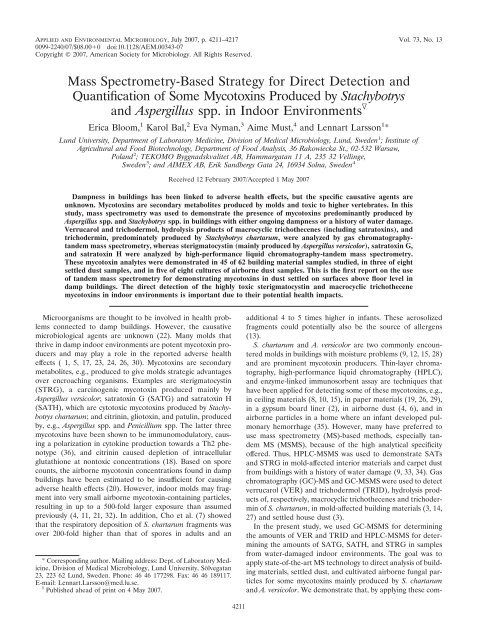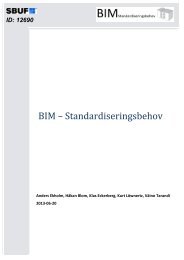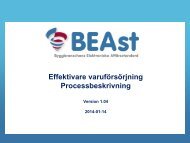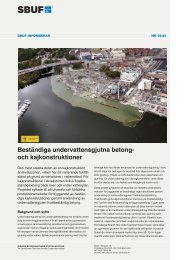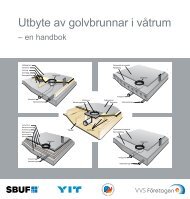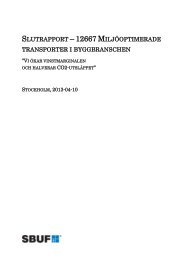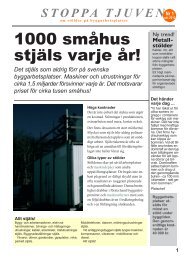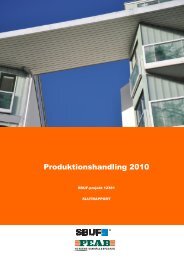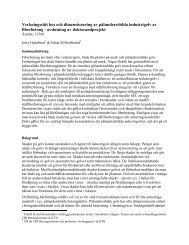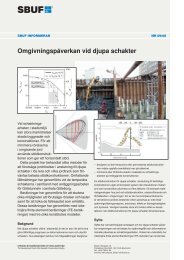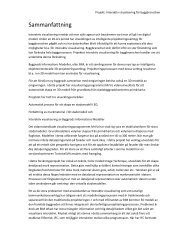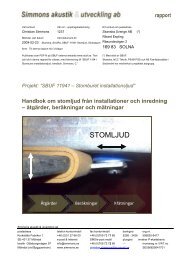Rapport SBUF-projekt: Mykotoxiner i inomhusmiljöer. Förekomst ...
Rapport SBUF-projekt: Mykotoxiner i inomhusmiljöer. Förekomst ...
Rapport SBUF-projekt: Mykotoxiner i inomhusmiljöer. Förekomst ...
You also want an ePaper? Increase the reach of your titles
YUMPU automatically turns print PDFs into web optimized ePapers that Google loves.
APPLIED AND ENVIRONMENTAL MICROBIOLOGY, July 2007, p. 4211–4217 Vol. 73, No. 13<br />
0099-2240/07/$08.000 doi:10.1128/AEM.00343-07<br />
Copyright © 2007, American Society for Microbiology. All Rights Reserved.<br />
Mass Spectrometry-Based Strategy for Direct Detection and<br />
Quantification of Some Mycotoxins Produced by Stachybotrys<br />
and Aspergillus spp. in Indoor Environments <br />
Erica Bloom, 1 Karol Bal, 2 Eva Nyman, 3 Aime Must, 4 and Lennart Larsson 1 *<br />
Lund University, Department of Laboratory Medicine, Division of Medical Microbiology, Lund, Sweden 1 ; Institute of<br />
Agricultural and Food Biotechnology, Department of Food Analysis, 36 Rakowiecka St., 02-532 Warsaw,<br />
Poland 2 ; TEKOMO Byggnadskvalitet AB, Hammargatan 11 A, 235 32 Vellinge,<br />
Sweden 3 ; and AIMEX AB, Erik Sandbergs Gata 24, 16934 Solna, Sweden 4<br />
Received 12 February 2007/Accepted 1 May 2007<br />
Dampness in buildings has been linked to adverse health effects, but the specific causative agents are<br />
unknown. Mycotoxins are secondary metabolites produced by molds and toxic to higher vertebrates. In this<br />
study, mass spectrometry was used to demonstrate the presence of mycotoxins predominantly produced by<br />
Aspergillus spp. and Stachybotrys spp. in buildings with either ongoing dampness or a history of water damage.<br />
Verrucarol and trichodermol, hydrolysis products of macrocyclic trichothecenes (including satratoxins), and<br />
trichodermin, predominately produced by Stachybotrys chartarum, were analyzed by gas chromatographytandem<br />
mass spectrometry, whereas sterigmatocystin (mainly produced by Aspergillus versicolor), satratoxin G,<br />
and satratoxin H were analyzed by high-performance liquid chromatography-tandem mass spectrometry.<br />
These mycotoxin analytes were demonstrated in 45 of 62 building material samples studied, in three of eight<br />
settled dust samples, and in five of eight cultures of airborne dust samples. This is the first report on the use<br />
of tandem mass spectrometry for demonstrating mycotoxins in dust settled on surfaces above floor level in<br />
damp buildings. The direct detection of the highly toxic sterigmatocystin and macrocyclic trichothecene<br />
mycotoxins in indoor environments is important due to their potential health impacts.<br />
Microorganisms are thought to be involved in health problems<br />
connected to damp buildings. However, the causative<br />
microbiological agents are unknown (22). Many molds that<br />
thrive in damp indoor environments are potent mycotoxin producers<br />
and may play a role in the reported adverse health<br />
effects ( 1, 5, 17, 23, 24, 26, 30). Mycotoxins are secondary<br />
metabolites, e.g., produced to give molds strategic advantages<br />
over encroaching organisms. Examples are sterigmatocystin<br />
(STRG), a carcinogenic mycotoxin produced mainly by<br />
Aspergillus versicolor; satratoxin G (SATG) and satratoxin H<br />
(SATH), which are cytotoxic mycotoxins produced by Stachybotrys<br />
chartarum; and citrinin, gliotoxin, and patulin, produced<br />
by, e.g., Aspergillus spp. and Penicillium spp. The latter three<br />
mycotoxins have been shown to be immunomodulatory, causing<br />
a polarization in cytokine production towards a Th2 phenotype<br />
(36), and citrinin caused depletion of intracellular<br />
glutathione at nontoxic concentrations (18). Based on spore<br />
counts, the airborne mycotoxin concentrations found in damp<br />
buildings have been estimated to be insufficient for causing<br />
adverse health effects (20). However, indoor molds may fragment<br />
into very small airborne mycotoxin-containing particles,<br />
resulting in up to a 500-fold larger exposure than assumed<br />
previously (4, 11, 21, 32). In addition, Cho et al. (7) showed<br />
that the respiratory deposition of S. chartarum fragments was<br />
over 200-fold higher than that of spores in adults and an<br />
* Corresponding author. Mailing address: Dept. of Laboratory Medicine,<br />
Division of Medical Microbiology, Lund University, Sölvegatan<br />
23, 223 62 Lund, Sweden. Phone: 46 46 177298. Fax: 46 46 189117.<br />
E-mail: Lennart.Larsson@med.lu.se.<br />
Published ahead of print on 4 May 2007.<br />
4211<br />
additional 4 to 5 times higher in infants. These aerosolized<br />
fragments could potentially also be the source of allergens<br />
(13).<br />
S. chartarum and A. versicolor are two commonly encountered<br />
molds in buildings with moisture problems (9, 12, 15, 28)<br />
and are prominent mycotoxin producers. Thin-layer chromatography,<br />
high-performance liquid chromatography (HPLC),<br />
and enzyme-linked immunosorbent assay are techniques that<br />
have been applied for detecting some of these mycotoxins, e.g.,<br />
in ceiling materials (8, 10, 15), in paper materials (19, 26, 29),<br />
in a gypsum board liner (2), in airborne dust (4, 6), and in<br />
airborne particles in a home where an infant developed pulmonary<br />
hemorrhage (35). However, many have preferred to<br />
use mass spectrometry (MS)-based methods, especially tandem<br />
MS (MSMS), because of the high analytical specificity<br />
offered. Thus, HPLC-MSMS was used to demonstrate SATs<br />
and STRG in mold-affected interior materials and carpet dust<br />
from buildings with a history of water damage (9, 33, 34). Gas<br />
chromatography (GC)-MS and GC-MSMS were used to detect<br />
verrucarol (VER) and trichodermol (TRID), hydrolysis products<br />
of, respectively, macrocyclic trichothecenes and trichodermin<br />
of S. chartarum, in mold-affected building materials (3, 14,<br />
27) and settled house dust (3).<br />
In the present study, we used GC-MSMS for determining<br />
the amounts of VER and TRID and HPLC-MSMS for determining<br />
the amounts of SATG, SATH, and STRG in samples<br />
from water-damaged indoor environments. The goal was to<br />
apply state-of-the-art MS technology to direct analysis of building<br />
materials, settled dust, and cultivated airborne fungal particles<br />
for some mycotoxins mainly produced by S. chartarum<br />
and A. versicolor. We demonstrate that, by applying these com-


